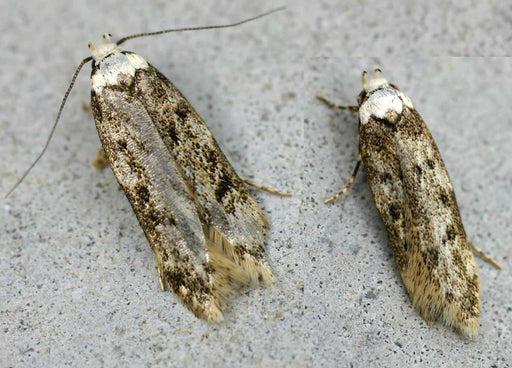The White Shouldered House Moth - A Homeowners Guide

Attribution: © entomart
The white shouldered house moth is a common species that belongs to the same sub-species as the brown house moth. The white shouldered house moth (Endrosis Sarcitrella) is now found worldwide due to its close association with human environments which creates plentiful food sources.
Unlike the webbing clothes moth and carpet moth, the white shouldered house moth is attracted to light and due to its constant all-year round breeding cycle can be found in houses, outbuildings and factory environments where dried food sources such as grain maybe found. However, it is omnivorous, eating foodstuffs such as grain, bran, flour and other cereals, but also feeding on wool and other animal based fabrics. Bird nests are a particularly ideal environment and, if any are located nearby, a risk for them entering the house.
Consequently, the white shouldered house moth as a pest is a risk to stored food in the same way as the pantry moth species, as well as to clothing and carpets, particularly when humidity levels are high.
The larvae are similar to other house moths, being a creamy white small caterpillar, and in the same way as the case-bearing clothes moth and carpet moth, they spin small cases in which they ‘hide’. The adult female white shouldered house moth, when mated, lays up to 200 eggs near to a suitable food source for the larvae that hatch within 1 to 2 weeks and start feeding immediately, feeding at night and hiding in the day. The adults live a shorter life than other similar moths, typically less than 3 weeks.
Pest Control
White shouldered house moths should be dealt with in a similar way to other house moth varieties:
- Very thorough vacuuming and cleaning of carpets, wardrobes and drawers
- Regularly disturbing and checking over stored clothing, blankets and other textiles
- Use of moth killing deterrents or at least natural alternatives
- Regular cleaning of the insides of food cupboards, larders and pantries
- Treating with a safe insecticide from our Natural Moth Control Range
- Storing dried food stuffs securely and ideally open packets in airtight storage containers
White Shouldered House Moth FAQs
When you put a term like “white moth in house” in your search engine, many answers can pop up online. Understandably, no one wants to find moths of any kind in their home. So what does it mean if you find white moths in your house? Are white moths dangerous? Will they damage your clothing? In this frequently asked questions guide, we will discuss some common questions about white moths and what to do if you find them in your home.
Why are there white moths in my house?
Moths enter houses for many reasons. Sometimes, moths fly into homes looking for places to hide or stay dry. For instance, if the weather is bad, a moth may try to find a quiet, warm place to hunker down. In other situations, moths get into houses because they are looking for a place to lay eggs. It all depends on the species of moth.
With that being said, if you have identified the moth species and realized that you definitely have White Shouldered House Moths in your home, you may want to consider taking measures to prevent an infestation. Unlike Clothes Moths, White Shouldered House Moths are attracted to light. As such, they tend to fly toward brightly-lit areas. Similarly to Pantry Moths, White Shouldered House Moths can feed on exposed stored food as well as animal fibre based fabrics such as wool, and may even lay eggs near a food source. So, you definitely want to get them out of your house right away.
Why do I suddenly have moths in my house?
There are many reasons that moths could suddenly appear in your house. Depending on where you live, moths could be migrating through your area. This can cause a sudden surge of fluttering moths in your home.
However, a surge of moths in your house could also mean that a generation of moths have just reached maturity and are now emerging to mate and lay eggs. If this is the case, extermination may be necessary.
The first step is to identify the type of moth you are dealing with. Then, you can take the proper steps to get them out of your house.
What types of moths are white?
Moths come in all different colours and various species can be white, mostly white, or a light whitish colour that is translucent.
Some white moth species are harmless and may be confused with pest type moths. For example:
- Satin Moth - Satin Moths are almost all white with legs that are checkered in colour. These moths hibernate during the winter and are active in Spring. Satin Moths can damage plants and trees, but will not do harm to your house.
- Peppered Moth - Although usually brown or tan, in Eurasia and North America, the peppered moth may occasionally come in white. They feed on plants in the larval stage.
- Miller - Miller Moths migrate during the summer months. Sometimes, they can be a creamy whitish colour.
- Lawn Moth - Lawn Moths are small and often come in a translucent shade of white. They tend to flutter around the grass and are not harmful to people or homes.
However the White Shouldered House Moth is a different species all together and can cause damage in your home. This moth has white on the tops of its wings near the head. It behaves in a manner that is similar to the Pantry Moth and should be removed from the home right away to protect your stored dry goods.
Are white moths in house spaces a problem?
It depends on the type of moth. Usually, white moths in your house are not an issue. Many moth species get into homes because they are looking for places to hide or stay dry, or are attracted to light sources. In most situations, they can simply be released back outside.
The pestilent species of moths that tend to lay eggs are most often brown or tan. Nevertheless, White Shouldered House Moths can present an issue. These moths are only partially white and can damage dried goods and textiles. If you have White Shouldered House Moths in your home, you should take steps to remove them immediately.
What do white moth eggs mean?
White moth eggs in your home are never a good sign and can be indicative of an infestation. Thoroughly clean your home and use Moth Killing Sprays to eliminate all eggs and larvae. Position Moth Traps to further monitor any presence of moths.
How long do white moths live in a house?
If you have a moth house infestation, it could go on until you serve an eviction notice. That is to say, some moths can live in houses for years, perpetuating the next generation indefinitely. So, if you have an infestation and want moths to go away, you will need to take action. Bearing that in mind, if a single white moth has accidentally fluttered into your home, it will likely only live a day or two and you don’t need to worry. Just shoo it back outdoors.
If you see a white shouldered moth you may want to be a little more vigilant and start using a Moth Killer Kit as they can live for up to 3 weeks.
Are white moths harmful?
Some white moths are not harmful to people, although the Satin Moth can be harmful to certain types of vegetation. However if you have identified a White Shouldered House Moth or a Clothes Moth in your home they can be very damaging to dried foods, carpets and animal fibre based clothing. It is important to remove them as soon as you spot any sign of an infestation.
About MothPrevention
MothPrevention® speak to customers every day about their clothes moth issues - clothes moths are a species that are ever increasing and that can cause significant damage to clothes, carpets and other home textiles.
To date, we’ve helped over 150,000 customers deal with their moth problems. We have developed professional grade solutions including proprietary pheromones engineered in Germany to the highest production standards.





